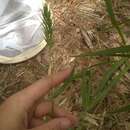Physical Description
provided by USDA PLANTS text
Perennials, Terrestrial, not aquatic, Stems nodes swollen or brittle, Stems erect or ascending, Stems caespitose, tufted, or clustered, Stems terete, round in cross section, or polygonal, Stem internodes hollow, Stems with inflorescence less than 1 m tall, Stems with inflorescence 1-2 m tall, Stems, culms, or scapes exceeding basal leaves, Leaves mostly cauline, Leaves conspicuously 2-ranked, distichous, Leaves sh eathing at base, Leaf sheath mostly open, or loose, Leaf sheath smooth, glabrous, Leaf sheath and blade differentiated, Leaf blades linear, Leaf blade auriculate, Leaf blades 2-10 mm wide, Leaf blades 1-2 cm wide, Leaf blades mostly flat, Leaf blade margins folded, involute, or conduplicate, Leaf blades mostly glabrous, Leaf blades more or less hairy, Leaf blades scabrous, roughened, or wrinkled, Ligule present, Ligule an unfringed eciliate membrane, Inflorescence terminal, Inflorescence simple spikes, Inflorescence a dense slender spike-like panicle or raceme, branches contracted, Inflorescence solitary, with 1 spike, fascicle, glomerule, head, or cluster per stem or culm, Inflorescence single raceme, fascicle or spike, Inflorescence spikelets arranged in a terminal bilateral spike, Flowers bisexual, Spikelets pedicellate, Spikelets sessile or subsessile, Spikelets laterally compressed, Inflorescence or spikelets partially hidden in leaf sheaths, subtended by spatheole, S pikelet less than 3 mm wide, Spikelets with 2 florets, Spikelets with 3-7 florets, Spikelets paired at rachis nodes, Spikelets all alike and fertille, Spikelets bisexual, Spikelets disarticulating above the glumes, glumes persistent, Spikelets disarticulating beneath or between the florets, Rachilla or pedicel hairy, Rachilla or pedicel glabrous, Glumes present, empty bracts, Glumes 2 clearly present, Glumes equal or subequal, Glumes shorter than adjacent lemma, Glumes equal to or longer than adjacent lemma, Glumes curved, bowed or swollen outward at base, Glumes awned, awn 1-5 mm or longer, Glumes 3 nerved, Glumes 4-7 nerved, Lemmas thin, chartaceous, hyaline, cartilaginous, or membranous, Lemma similar in texture to glumes, Lemma 5-7 nerved, Lemma glabrous, Lemma body or surface hairy, Lemma apex acute or acuminate, Lemma distinctly awned, more than 2-3 mm, Lemma with 1 awn, Lemma awn less than 1 cm long, Lemma awn 1-2 cm long, Lemma awn 2-4 cm long or longer, Lemma awned from tip, Lemma awns straight or curved to base, Lemma margins thin, lying flat, Lemma straight, Palea present, well developed, Palea membranous, hyaline, Palea about equal to lemma, Palea longer than lemma, Stamens 3, Styles 2-fid, deeply 2-branched, Stigmas 2, Fruit - caryopsis, Caryopsis ellipsoid, longitudinally grooved, hilum long-linear, Caryopsis hairy at apex.
Elymus virginicus: Brief Summary
provided by wikipedia EN
Elymus virginicus, or Virginia wildrye, is a perennial bunchgrass located in Virginia and the eastern United States. Virginia wild rye is one of the few cool season native grasses found in the east Texas area. It is extremely palatable to livestock and will decrease without proper grazing management. It spreads via seed and tillering. It can be confused with Canadian wild rye which is a more robust plant with longer awns. It should be cut early in the season when used for hay to avoid ergot contamination. Northern Missouri Germplasm Virginia wild rye was released in 1999 by the Missouri Plant Material Center for use in northern Missouri.
- license
- cc-by-sa-3.0
- copyright
- Wikipedia authors and editors

